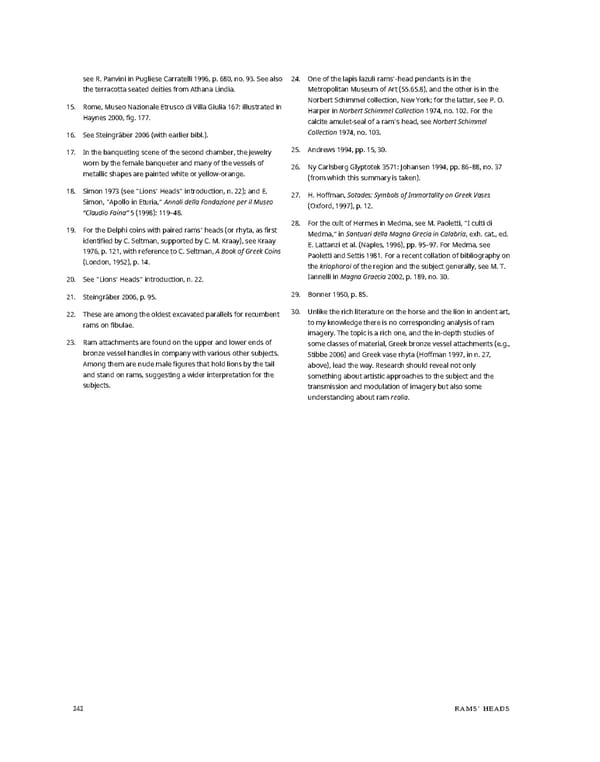see R. Panvini in Pugliese Carratelli 1996, p. 680, no. 93. See also 24. One of the lapis lazuli rams’-head pendants is in the the terracotta seated deities from Athana Lindia. Metropolitan Museum of Art (55.65.8), and the other is in the 15. Rome, Museo Nazionale Etrusco di Villa Giulia 167: illustrated in Norbert Schimmel collection, New York; for the latter, see P. O. Haynes 2000, fig. 177. Harper in Norbert Schimmel Collection 1974, no. 102. For the calcite amulet-seal of a ram’s head, see Norbert Schimmel 16. SeeSteingräber 2006 (with earlier bibl.). Collection 1974, no. 103. 17. In the banqueting scene of the second chamber, the jewelry 25. Andrews 1994, pp. 15, 30. worn by the female banqueter and many of the vessels of 26. Ny Carlsberg Glyptotek 3571: Johansen 1994, pp. 86–88, no. 37 metallic shapes are painted white or yellow-orange. (from which this summary is taken). 18. Simon 1973 (see “Lions’ Heads” introduction, n. 22); and E. 27. H. Hoffman, Sotades: Symbols of Immortality on Greek Vases Simon, “Apollo in Eturia,” Annali della Fondazione per il Museo (Oxford, 1997), p. 12. “Claudio Faina” 5 (1998): 119–48. 19. For the Delphi coins with paired rams’ heads (or rhyta, as first 28. For the cult of Hermes in Medma, see M. Paoletti, “I culti di identified by C. Seltman, supported by C. M. Kraay), see Kraay Medma,” inSantuari della Magna Grecia in Calabria, exh. cat., ed. 1976, p. 121, with reference to C. Seltman, A Book of Greek Coins E. Lattanzi et al. (Naples, 1996), pp. 95–97. For Medma, see (London, 1952), p. 14. Paoletti and Settis 1981. For a recent collation of bibliography on the kriophoroi of the region and the subject generally, see M. T. 20. See “Lions’ Heads” introduction, n. 22. Iannelli in Magna Graecia 2002, p. 189, no. 30. 21. Steingräber 2006, p. 95. 29. Bonner 1950, p. 85. 22. These are among the oldest excavated parallels for recumbent 30. Unlike the rich literature on the horse and the lion in ancient art, rams on fibulae. to my knowledge there is no corresponding analysis of ram imagery. The topic is a rich one, and the in-depth studies of 23. Ram attachments are found on the upper and lower ends of some classes of material, Greek bronze vessel attachments (e.g., bronze vessel handles in company with various other subjects. Stibbe 2006) and Greek vase rhyta (Hoffman 1997, in n. 27, Among them are nude male figures that hold lions by the tail above), lead the way. Research should reveal not only and stand on rams, suggesting a wider interpretation for the something about artistic approaches to the subject and the subjects. transmission and modulation of imagery but also some understanding about ramrealia. 242 RAMS’ HEADS
 Ancient Carved Ambers in the J. Paul Getty Museum Page 251 Page 253
Ancient Carved Ambers in the J. Paul Getty Museum Page 251 Page 253